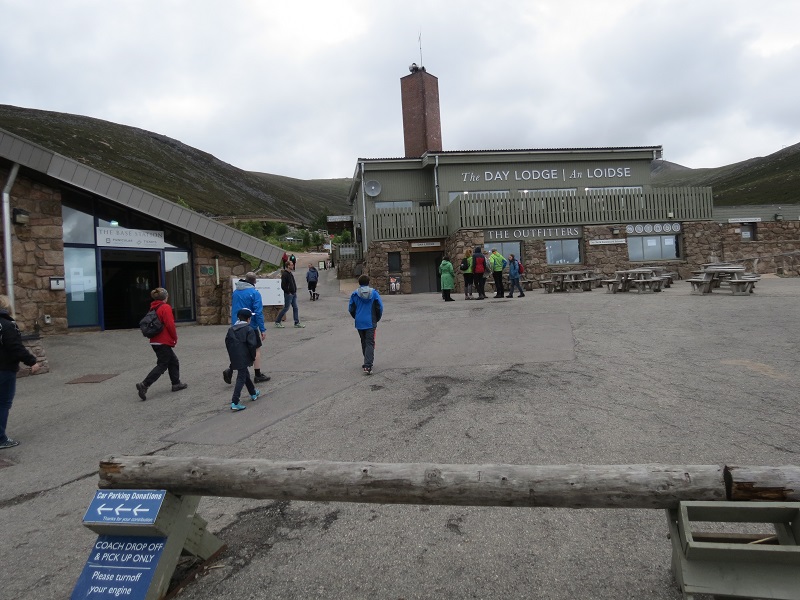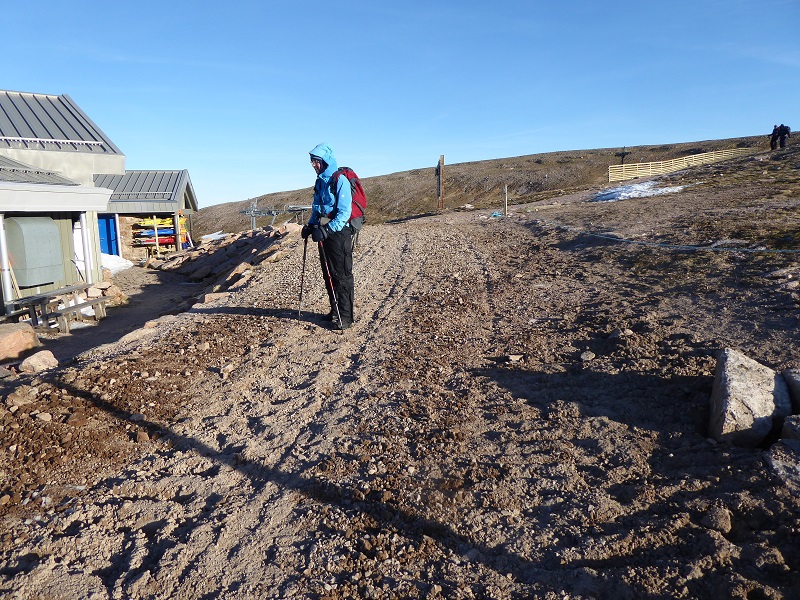
Highlands and Islands Enterprise’s news release on 12th April (see here) on its latest plans for Cairn Gorm – or “CairnGorm Mountain” in marketing speak – was widely taken up by the press. HIE must be delighted there was so little critical coverage but their announcement raises a number of serious questions.
The truth is that the long promised masterplan, if it exists, is not yet public and the only agreement there has been is between HIE and Natural Retreats, the organisation that now run Cairngorm. Nothing resembling a plan has been issued or is available on either the Cairngorm Mountain or HIE website. So, for example, no indication has been given about where the proposed dry ski slope will be located nor how that proposal will meet environmental requirements. The design and location of the dry ski slope and proposals for environmental mitigation are absolutely crucial for determining whether the Cairngorms National Park Authority should give ANY consideration to the new “plan” – yet HIE claims the masterplan has been agreed. Either there has been yet more shady behind the scenes negotiations or this is pure spin! I suspect the latter.
However, there is a reason I believe for the spin and that is if HIE can get a head of steam up behind the proposal and convince people that in this lies the economic salvation of Speyside, it will make it much harder for the Cairngorms National Park Authority to reject the proposal, however awful it might be. Hence the emphasis in the News Release about the new jobs that HIE claims will be created – 35-45, but nothing of course about pay or working terms and conditions – and this just a few weeks after Natural Retreats had been threatening to make a large proportion of the workforce at Cairngorm redundant.
Rather than a masterplan, what has been made public is that HIE has agreed to re-direct the loan of £4 million its Board had previously agreed with Natural Retreats to construct a new Day Lodge (see here for legal agreement obtained under FOI). It is now being proposed that the loan should be used for the construction of a dry ski slope and to make changes to the Ptarmigan Restaurant at the top of the funicular, doubling the size of the restaurant and creating a viewing platform.
The rationale behind the Ptarmigan part of the proposal is obvious, to increase numbers of people using the funicular, but whether it is sensible is another matter. The funicular has been a disaster from start to finish, both for skiers and day visitors, but HIE management and funding of the Cairn Gorm estate has been driven by the need to justify it and keep it afloat financially: HIE’s one and only idea about how to do this up till now has been to increase the numbers of paying visitors in summer. Why take the funicular in summer though when all you can do is walk around inside the Ptarmigan restaurant, because the soils and vegetation on Cairn Gorm are just too fragile to sustain thousands of visitors, or be escorted to the top of Cairn Gorm and back by Rangers for a price. The wrap around viewing platform proposal would appear to be an attempt to enable more visitors to experience fresh air – or should that be the more usual howling gale at the top of Cairn Gorm? – and expansion of the restaurant designed to allow people to sit around for longer periods at the Ptarmigan spending money.

The key problem for though for HIE is when Cairn Gorm is shrouded in cloud, as it is for much of the year, why would anyone visit? Not many people want to pay a £12 entry fee (the cost of the funicular) to a restaurant. On clear days, given the legal agreement in place preventing funicular users leaving the stop station, for those fit enough to do so, its much better to walk up Cairn Gorm and, for those who are not, to walk elsewhere. The whole concept of attracting people to the top of the mountain to sit inside is fundamentally flawed yet HIE persist with it. The wider flaw in their thinking though is the belief that people visit National Parks primarily for a manufactured tourist experience rather than for the great outdoors. A strategy built on trying to extract large amounts of money from people for poor experiences is just not going to work.
What you can charge money for at Cairn Gorm is for skiing and there is a hint in the news release that at long last HIE realise that if they want to make the Cairn Gorm ski facilities financially viable, they need to make it a better place for skiing. One part of that is to try and compensate for poor snow cover as this year- hence the dry ski slope proposal in an attempt to guarantee beginners a ski experience. That however will not bring in enough people to make the ski area financially viable. What’s needed is a complete re-think of skiing at Cairngorm within the context of the challenges posed by global warming. There is no sign of HIE doing this, instead they are “lending” money to Natural Retreats.
Financial questions that need to be asked
The first question HIE needs to answer is what, if anything, are Natural Retreats going to invest in the Cairn Gorm ski area? While the HIE News Release referred to HIE’s £4m loan to CairnGorm Mountain Ltd, it said not a thing about any financial contribution from Natural Retreats. I suspect that this is because Natural Retreats are contributing nothing. CML at the end of December 2015 had net liabilities of £776,328 and while 2016 was a good ski season, 2017 has been awful and its safe to conclude CML has no money to invest – that is why is was threatening to lay off staff just a few weeks ago. Its owner, Natural Assets Investment Ltd is ostensibly in a far worse financial position, with net liabilities at 31st December 2015 of £38,083,245 (see here for consideration of both sets of accounts).
The second question HIE needs to ask is on what basis do they believe CML will ever pay the loan back given the losses currently being made by the company? CML had a £1,219,606 operating loss in the nine months to December 2015. I assume HIE has already produced a set of visitor projections to the new Ptarmigan and the dry ski slope that shows projected income exceeding projected expenditure and how the loan will be repaid. While any such projections should be treated with healthy scepticism – remember how the funicular would have paid for itself by now – HIE needs to explain how any projected extra income will also offset the current massive operating loss.
The third question HIE needs to answer therefore is why is it lending money to a company that is basically insolvent and dependent on the goodwill of hedge fund manager, David Michael Gorton, the ultimate owner? When selling CML HIE retained most of the assets at Cairngorm, including the land and lift infrastructure. Why not then simply pay for the new assets itself and retain them in public ownership rather than lend money so they end up in the hands of a hedge fund manager whose companies appear to be going bust? The safe way to get the money back would be to keep the asset and then to charge extra rent to CML for the use of those assets?
I suspect the reason this option is not being taken is because of neoliberal dogma, that public assets and public investment are bad and everything is best done through the private sector. The financial evidence in this case (as in many others) suggests otherwise and that HIE is creating a disaster at Cairn Gorm. HIE will no doubt claim that it will secure its loan as it it did in its agreement with CML over the day lodge (see link in paragraph 4 above). That agreement states CML cannot sell the new assets financed by the HIE loan without permission. That sounds fine until a company goes into liquidation – and CML appears heading that way – when its assets are distributed among all creditors which would inevitably result in HIE getting back less than what it put in. I am not an expert in these things but its looks to me as though its almost impossible for HIE to secure its loan properly.
The wider questions about Cairn Gorm
Part of the justification for selling Cairngorm Mountain to Natural Retreats was to enable much needed investment in facilities to be financed by the private sector – the latest investment announcement suggests that is no nearer to happening. If investment depends on the public sector, the obvious question is why have the private sector involved at all?
The answer is that sometime the private sector has expertise that the public sector lacks. However, Natural Retreats was a new company with little experience and no expertise in skiing – so why then did HIE choose them? There were – and are now – local people and businesses who are prepared to work together and manage Cairn Gorm for the benefit of everyone and keep money invested in the local area. The biggest question therefore which HIE needs to answer is why its still pressing ahead with financing Natural Retreats instead of putting its efforts into supporting a community enterprise to takeover and run Cairn Gorm?
It would appear from the HIE News Release is that the proposal to redevelop the Day Lodge has now been abandoned. The delivery of a new Day Lodge was a condition of HIE’s lease with Cairngorm Mountain and set out in Schedule 4. That schedule now needs to change and it appears therefore that HIE would, if it gave notice to Natural Retreats to terminate the lease now, be secure from any legal challenge. It has no excuse for not doing so.
The public investment at Cairn Gorm is a good thing – its just being given to the wrong people for the wrong purpose. Its time our politicians appreciated this and started arguing for alternatives.

Good article. You raise many questions that deserve answers.
What baffles me most is the lack of any plans for funicular served downhill mtb trails. This would increase summer visitors numbers more than a larger restaurant, and if properly installed would have less environmental impact than the existing ski infrastructure and operations.
The Press and Journal article indicated that the plans for a mountain bike trail had been abandoned but not for what reason. It also said plans for a zip wire had been dropped.